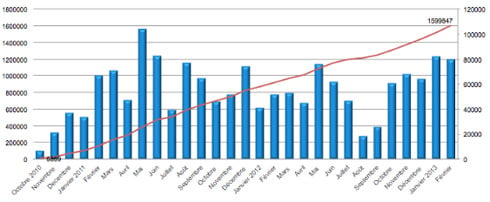 In a step away from some of the more historically aggressive anti-piracy schemes against individual Internet users, during the last couple of years there has been a settling on a perceived middle-ground.
In a step away from some of the more historically aggressive anti-piracy schemes against individual Internet users, during the last couple of years there has been a settling on a perceived middle-ground.
In some countries rightsholders are now permitted to inform Internet users via their ISPs that their illicit habits are being noted, allowing users to maintain a theoretical level of privacy while an educational message is imposed.
The result are so-called
Yesterday the French government’s Hadopi agency released the latest stats from their scheme and they reveal a huge increase in the effort.
In January 2012, Hadopi sent 41,396 so-called “first strike” warnings to Internet users. During January 2013 the agency sent 82,000, a 98% increase.
The following month saw a similar trend. In February Hadopi sent out 80,000 initial warnings versus 51,621 in the same period last year.
To find months with a greater output we have to go all the way back to May and June 2011, where 103,989 and 82,795 first warnings were issued respectively.
The trend looks like it will continue. In January this year Hadopi announced it would step up its game and for the last five consecutive months the number of warnings sent has not dipped below 61,000, which has never happened in Hadopi’s history.
The chart below shows first-strike warnings issued to the end of February 2013, with the red line representing the cumulative amount, a total of 1,599,847.

While first strikes are indeed important, the instances of subsequent strikes are perhaps more indicative of how well the system is performing when it comes to its educational aims.
Taking the last two months as examples and comparing them to the same periods last year, we see that the huge increase in first strike warnings sent does not proportionately affect the totals of second strike warnings.
In January 2012 a total of 6,450 second warnings were issued, versus 7,350 in January 2013. That’s just a 14% uplift despite 98% more initial warnings delivered.
In February 2012 a total of 7,350 second strikes went out, versus 8,550 this year. That represents just a 16.3% increase in second strikes in 2013 even though around 55% more initial warnings went out.
The chart below shows second-strike warnings issued to the end of February 2013, with the red line representing the cumulative amount, a total of 138,953.

But perhaps of most interest is the numbers of Internet account holders who despite first and second warnings still go on to a third. Perhaps surprisingly, despite the large increase in warnings sent, roughly the same amount of people are receiving their final strike each month.
January 2012 saw 38 individuals received their third warning, versus 36 in the same month this year. A total of 41 people had their final strike in February 2012 compared to 33 in February 2013. No matter how many first or second warnings were sent out, in no month since the scheme began have more than 43 people received a third.
The chart below shows third-strike warnings issued to the end of February 2013, with the red line representing the cumulative amount, a total of 488.

Despite the stats detailed above, it remains difficult to assess the street-level success of the scheme. The numbers of first strike warnings sent versus the constant level of thirds could suggest that people are indeed heeding the warnings, but it could also mean that they’re shifting to other file-sharing systems that are more difficult to monitor. On the other hand it may be that Hadopi only has the stomach or capacity to deal with the amount being passed to judges so far.
The truth is there can only ever be one real barometer of success – a large uplift in the revenues of entertainment companies. As far as we can see, that reward is yet to be observed.





